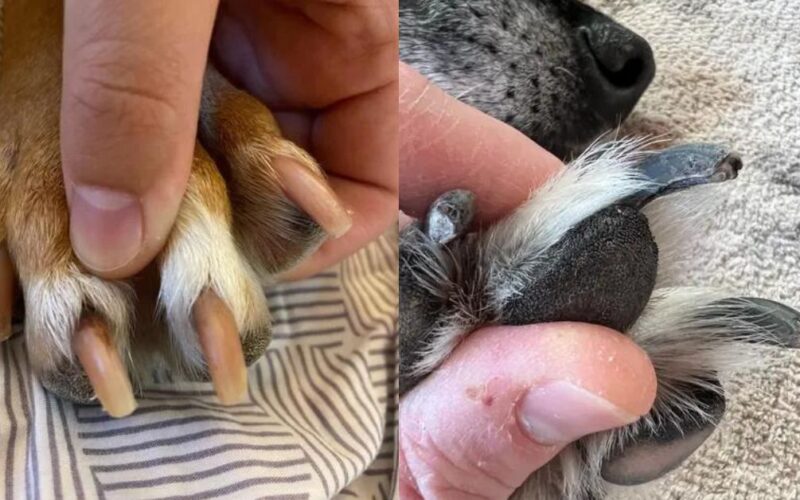“Dog nails loud on floor”, I get it! Keeping your dog groomed looks like a hassle but it should be a priority. If it’s been a long time since you have cleaned your dog’s paws and now you are listening to clicking sounds while they walk then hear me out it is the time to cut their nails as it’s super uncomfortable not only for your ears but for your dog too.
Should Dog Nails Click On The Floor?
No, dogs’ nails should not click on the ground while walking as clicking and tapping sounds indicate that their nails are very long. Long nails are uncomfortable for a dog’s paw and can cause joint issues. This also damages your wood or tile floors. Best is to trim them ASAP.
You might be interested to know like, Do dogs trim their own nails?
Are Dogs’ Nails Supposed to Click on the Floor?
No, the nails are not supposed to click on the floor when they are walking, it means that their nails are too long and they need a trimming. It can lead to discomfort for your dog.
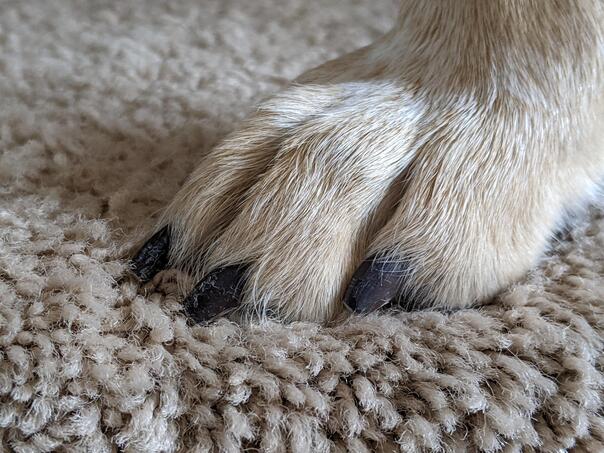
Other issues are;
Kind of Discomfort for the Dog
Long nails that are clicking on floors can be uncomfortable for your dogs just as long fingernails are uncomfortable for humans. When their nails are not trimmed they can cause your dog to walk a little differently, altering their gait and potentially causing some kind of pain and discomfort.
Can Cause Joint and Posture issues
When the nails are too long they can affect the posture of your dog and their joint health is affected. They will often adjust the way they walk so that they can compensate for the discomfort. It can slowly lead to joint problems and muscle strain with time.
It Damages The Floors, Furniture, AND YOU
The long nails can cause damage to your floors, furniture, and skin in case your dog jumps on you and playfully paws at you. If a dog has nails longer than normal length they can also scratch the hardwood floors and furniture as these are common problems when not maintained properly.
At Risk of Ingrown Nails
If the nails are excessively long then they are more prone to splitting or becoming ingrown they can be painful and will need veterinary attention.
Risk of infection
Very long nails can trap dirt and debris which can lead to fungal issues and infection in the nail bed.
To prevent these kinds of issues it is very important that you should trim the nails of your dog regularly or you can also get them groomed by a professional groomer or veterinarian.

The frequency of nail trimming depends on the breed of your dog, activity level, and the type of surfaces they usually walk on. It depends on your dog because some dogs get their nails trimmed every few weeks while some dogs can go longer between trims.
10 Ways to Tell Your Dog’s Nails Are Too Long
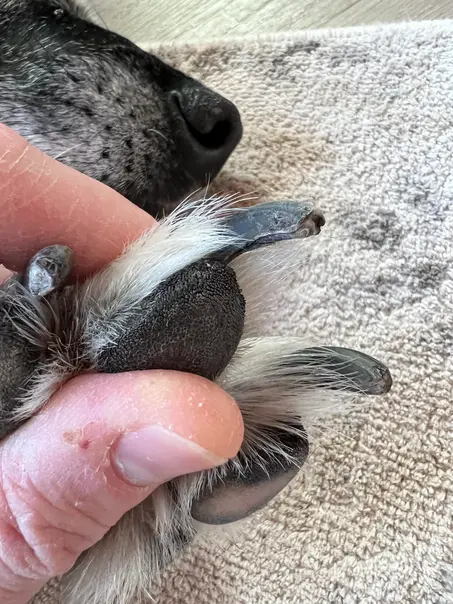
Clicking Sounds:
One of the most common signs which is mentioned a lot of times in the article too is clicking sounds as dogs walk on any hard surfaces.
Scratching:
Long nails will scratch and damage the floors, furniture, and also your skin when your dog paws at you.
Visible Length:
Another way to see is to visually inspect your dog’s nails as if they extend significantly beyond the paw pad they are too long.
Changes in Gait:
When dogs have long nails they can alter their gait or the way they walk to compensate for the discomfort which can result in noticeable changes in how they move.
Difficulty Walking:
If the case is too severe, dogs with very long nails can also have difficulty when they are walking, especially on smooth and slippery surfaces.
Pain or Discomfort:
Dogs can show signs of pain and discomfort when their nails are very long. This will include limping, favoring one paw, and showing signs of distress.
Nail Curling:
In some cases nails can become so long that they curl under the paw; it not only causes discomfort but also increases the risk of injury.
Snagging:
Long nails are more likely to snag on objects, potentially causing pain or injury to your dog.
Injury Risk:
Dogs with long nails are also at a higher risk of nail injuries which include broken nails or torn nail beds.
Paw Posture:
Observe your dog’s paw posture when they are walking. If they hold their paws differently it may be a sign of discomfort to long nails.
Keep checking the nails of your dog and address them promptly if they are very long and make sure the paws remain healthy and pain-free.
How Long Should Dog Nails Be?
Correct length for nails will vary depending on the individual dog, their breed size, and their activity level. In general, the nails should be kept short enough that they do not touch the ground when the dog is standing or walking. Trimmed nails also prevent scratching when they jump on you.
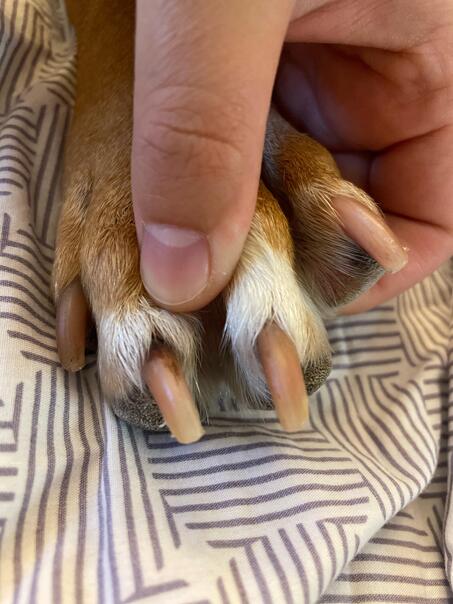
Tips for Making Nail Trimming a Positive Experience:
Some tips to ensure that nail trimming becomes a positive experience for your dogs are given below:
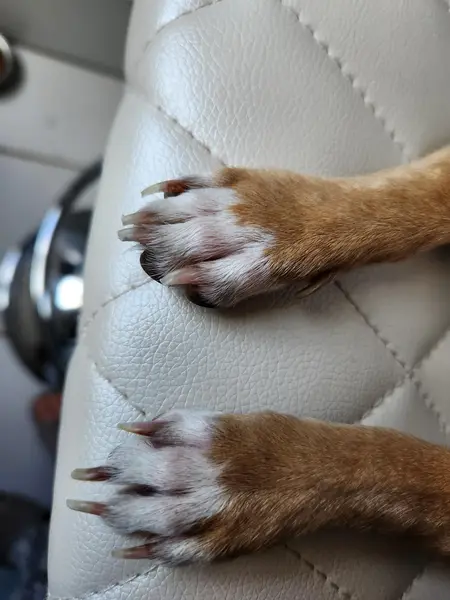
Choose the right time
Pick a time when your dog is relaxed and not very energetic. Avoid trimming after exercise or during his active hours.
Use high-quality clippers
Always invest in good quality clippers and grinders to ensure a smooth and painless trimming procedure. Dull tools will cause discomfort and splintering of the nail.
Let them know that clippers are not harmful
When you are going to cut nails for the first time, start by getting your dog used to the sight and sound of clippers and grinders without trimming. Also, allow them to sniff and investigate these tools. Turn them on for grinders or click them without using a dog.
Do massage for gentle relaxation
Before you start trimming, give your dog a gentle paw massage so that they can relax. Make it a very soothing experience by talking gently and petting them.
Reward them for calm behavior
You can use treats, praise, and rewards so that a positive association can be created when nails are getting trimmed. Offer them small, tasty treats during the process as a reward for their calm behavior.
Take it slow
Start by trimming one or two nails at a time, especially in times when your dog is anxious or unaccustomed during the procedure. Increase the number of nails gradually as your dog will become more comfortable slowly.
Stay calm
Dogs can pick up emotions so stay calm and composed during nail trimming. If you are nervous or anxious your dog can also become anxious.
Know when to stop:
If your dog is very stressed or resistant during trimming it is okay to stop and try again later. If you force them it can hurt them or create negative associations.
The key is to make the entire process positive and a low-stress experience for your dog. With patience and consistency, dogs can learn to tolerate and enjoy this process.
Now in the end, I hope this blog has helped you.
